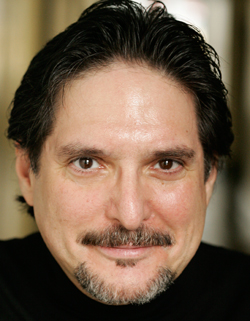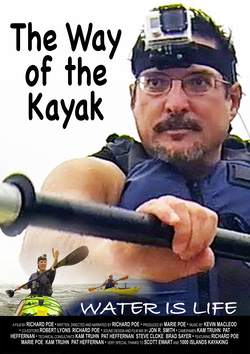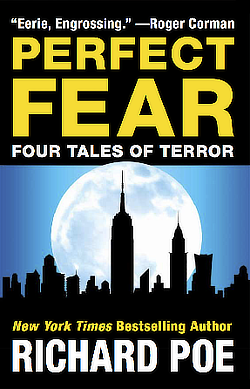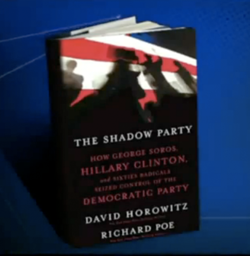PERFECT FEAR: Author’s Forenote
by Richard Poe
Reprinted from Perfect Fear (released by Heraklid Books, July 5, 2012)
WELCOME to Perfect Fear. This book is a collection of four tales of terror, written by me. If you just want to read the stories, skip directly to page one. Skip the pages marked by Roman numerals, and go directly to the first story, “Scotophobia.”
My guess is that most readers will just want to read the stories. However, Perfect Fear contains a goodly amount of additional material, above and beyond the stories, which some readers may find of interest. About 40 percent of this book consists of bonus content. That’s a new term in book publishing. Many readers may not be familiar with it. The term “bonus content” is mainly used in the home video business. Over time, however, I think book buyers will become increasingly familiar with this expression. Bonus content is an idea of the future.
The Bonus Content Revolution
Nowadays, when people buy a DVD or a Blu-ray disc, they expect more than just a movie. They expect to receive “extras” or “special features.” These “extras” might include mini-documentaries on the making of the film, interviews with the director and actors, learned commentaries from film critics and film historians, deleted scenes, bloopers, theatrical trailers, and more. All these features are included on the disc, at no extra cost. In the early days of DVDs, “special features” were included only with certain types of movies, such as Citizen Kane, which were known to be popular with hard-core film buffs. Very soon, however, video buyers started demanding more bonus content for more types of films. Today, a large and growing number of viewers have become so addicted to bonus content, they won’t buy any movie at all, unless it comes packed with extra features.
In effect, the “extras” created a more educated audience. The more “extras” people watched, the more they learned about the nuts and bolts of filmmaking. And the more they learned, the more they wanted to learn. Nowadays, even the lowliest, straight-to-video B-movies, made by obscure or first-time directors, often come rolling off the DVD presses bristling with extra content. An entire industry has grown up, dedicated to producing bonus content for home videos.
Bonus Content for Books
I believe that book publishing is moving in a similar direction. Many e-books already carry bonus content. And, thanks to cost-cutting technologies in printing and book design, even physical, paperback books can now be produced so cheaply that large numbers of pages can be devoted to bonus content, without raising the price.
Personally, I welcome the bonus content revolution. I’m one of those people who can’t get enough information. When I’m reading a book or watching a video, I often close the book or freeze the video at odd moments, to take an info break, searching Google for background information on the work in question. Any tidbit I can learn about the author or director helps me enjoy the work more.
In planning this first edition of Perfect Fear, I tried to create a package that would appeal to infomaniacs like myself. The extra features in Perfect Fear include an in-depth author interview by fellow horror writer Paul Germano; two scholarly commentaries on my stories by literary critics Nina Zivancevic and David Yeagley; and, finally, a prologue and epilogue by yours truly, in which I share with readers some of the spiritual and psychological compulsions which led me to write Perfect Fear. If you find that sort of thing boring, no problem. Don’t read it! Just skip right to the stories.
Why I Self-Published This Book
Perfect Fear is a self-published book. Some readers may wonder why I chose this route. After all, I have had a long and successful career in mainstream publishing. Over the last twenty years, I have published ten books through mainstream houses, and have sold nearly one million copies in the United States. My books have been translated into 21 foreign languages, and my publishers have included such iconic institutions as Random House, HarperCollins and McGraw-Hill. So why turn to self-publishing now? The main reason is that Perfect Fear is a work of fiction. All my previous books were in the non-fiction category. When you’ve spent twenty years of your life writing non-fiction books, it is very difficult to convince agents and editors to let you try something different. In the case of Perfect Fear, I didn’t even make the attempt. Life is short, and I didn’t feel like arguing. So I just went ahead and published Perfect Fear myself.
Publishing a book is a huge task, requiring specialized knowledge in many fields. When you write for a major publisher, everything is done for you. All you have to do is write. But once you make that fateful decision to self-publish, you become responsible for every aspect of your book. That responsibility can be daunting.
In publishing Perfect Fear, I was fortunate to be assisted by the same winning team that helped me become a bestselling author in the first place. Jennifer Basye Sander was my editor at Prima, then later at Random House. She oversaw and helped conceptualize many of my most successful books. Vanessa Perez was the art director who designed many of those same books (or, in some cases, supervised the design), first at Prima, then later at Random House.
Jennifer and Vanessa are now in business for themselves, helping authors like me make the transition to the digital publishing era. Vanessa designed Perfect Fear and Jennifer advised me on many aspects of producing, packaging and marketing the book. I could not have managed without them. Whatever success Perfect Fear may enjoy, Jennifer and Vanessa deserve much of the credit. For the many obvious faults in this book, I am, of course, solely responsible.
Richard Poe
May, 2012
Reprinted from Perfect Fear (released by Heraklid Books, July 5, 2012)







